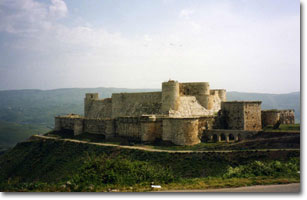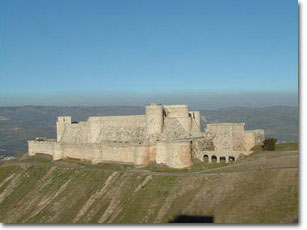|
 41 km
west of Homs; as the Parthenon is to Greek temples, so is the Krak des
Chevaliers to medieval castles, the supreme example, one of the great
buildings of all times. Many superlatives have been spent on this
monument but few do it full justice. No matter how many times you visit
the great fortress, it never presents the same face. 41 km
west of Homs; as the Parthenon is to Greek temples, so is the Krak des
Chevaliers to medieval castles, the supreme example, one of the great
buildings of all times. Many superlatives have been spent on this
monument but few do it full justice. No matter how many times you visit
the great fortress, it never presents the same face.
The Krak is certainly the supreme example of Crusader castle building,
showing the full flowering of the Hospitables' style which went far
beyond the stolid adaptations of Byzantine models that had previously
influenced the castles of the first half of the 12th century. The site lies on a hill called Jebel Kalakh (or Tell Kalakh), part of
the Mount Lebanon/Jebel Ansariye range near the famous gap that lead to
Homs from the sea. This position had long been an important defensive
site before the Crusaders arrived. There is some evidence that the
Egyptians of the 18th dynasty took an interest in it during their
struggle with the Hittites for domination of Syria. 
The Crusaders first reached here in February 1099 when Raymond de Saint
Gills, Count of Toulouse, resumed his journey south to Jerusalem after
the bloody taking of Maarat al-Numan. The site was reoccupied by the
Emir of Homs when the Crusaders passed on. It was not until 1110 that
it was retaken by Tancred, Regent of Antioch. The castle was given to
the Count of Tripoli. The rationalization of the crusaders' resources came in 1144 when
Raymond II, Count of Tripoli, transferred the Krak along with his other
dependant castles to the Knights Hospitaller. Founded possibly earlier
than the 12th century, its presence was extended to other Crusader
principalities as its influence grew and as the need for an
organization devoted to the common defense of the Crusader states
became more evident. The crusader castle survived two major Muslim challenges in the late
12th century. She's still standing to witness all events that passed.
Nūr al-Din was beaten beneath the castle in 1163 by a strong coalition
of Christian forces from Tripoli and Antioch. In 1188, moving up the
coast after his great victory over the Kingdom of Jerusalem at Hattin,
Saladin united the Muslim forces of Egypt, Syria and Mesopotamia, and
by-passed the castle after a one day trial siege but ravaged the rest
of the Count of Tripoli's territory. In 1267, the Mamelukes under Sultan Baybars began a concerted effort to
assert Muslim supremacy in Syria. He invested the Krak on 21 February
1271. Baybars bottled up the Hospitallers in the inner defenses. He
forced them to surrender on favorable terms on 7 April. Gradually as the foreign threat disappeared, it fell into disuse as a
military strongpoint, Muslim villagers settled in it and remained there
until cleared out by the French antiquities administration in 1934. The
French arrested the damage that the centuries of civilian occupation
had brought, even declaring the building a "monument of France".
Considerable work has been done since 1946 to continue the work of
restoring and safeguarding the fabric of the building. The Krak has two district lines of fortifications: the outer, a curtain
wall protected by round towers; and the inner ring which clusters
tightly on the south side around the innermost keep, protected by its
great sloping base. The western outer ring with its five beautifully
balanced and evenly spaced towers along the 150 m stretch of wall that
Deschamps has described as "an architectural perspective based on
perfect harmony". The Chapel:  It dates from the first phase of the Hospitaller fortress (1142 - 70)
when Romanesque influence was still evident. The nave, divided into
three bays, ends in an apse roughly oriented towards the east. On the
southern side are three roughly-carved niches. These result from the
conversion of the chapel to a mosque following the Mameluke occupation
and are intended to orient the faithful towards Mecca during prayers.
The chapel is bare of decoration except for the barrel vaulting, a
plain cornice and the slender support pilasters. The original doorway
to the chapel was largely covered over by a staircase probably built
during the final siege. It dates from the first phase of the Hospitaller fortress (1142 - 70)
when Romanesque influence was still evident. The nave, divided into
three bays, ends in an apse roughly oriented towards the east. On the
southern side are three roughly-carved niches. These result from the
conversion of the chapel to a mosque following the Mameluke occupation
and are intended to orient the faithful towards Mecca during prayers.
The chapel is bare of decoration except for the barrel vaulting, a
plain cornice and the slender support pilasters. The original doorway
to the chapel was largely covered over by a staircase probably built
during the final siege.
Towers:  There are 11 towers and 2 bastions on the curtain wall (the outer
ring), and 5 tower, 1 bastion and 1 chapel (mentioned) on the inner
ring. Two of the towers are distinguished with names for some stories. There are 11 towers and 2 bastions on the curtain wall (the outer
ring), and 5 tower, 1 bastion and 1 chapel (mentioned) on the inner
ring. Two of the towers are distinguished with names for some stories.
The tower of the King's Daughter: The lower part of this tower is 12the century but the upper (with
machicolations) is Arab. From the tea room on the upper floor a
beautiful view including Safita and the coast can be seen. The Tower of the Windmill: it is one of the five half-round towers on the outer ring of the
defenses. It used to house a windmill and so it earned its name. |


